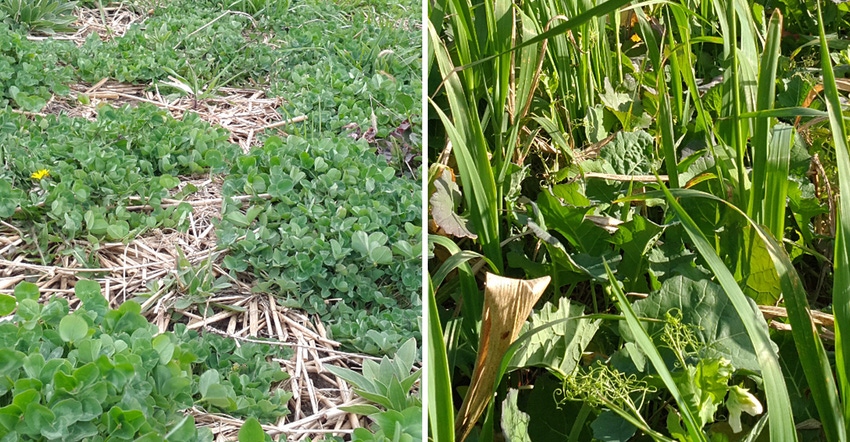May 17, 2017

If you have small grains planted on your farm this year, harvesttime will be here before you know it. But the grain harvest is just the beginning. Many farmers put small grains back into the rotation so they can plant pretty much any cover crop they want and reap its full potential. Planting them in August is the only surefire way to get a thick stand of sorghum-sudangrass for winter grazing, some nitrogen fixation from the legumes, and those giant turnip and radish tubers that you only ever see in magazines.
To be sure, there are many benefits of having cover crops between corn and soybean crops that make them a no-brainer: controlling erosion, binding up free nutrients and suppressing some weeds in soybeans. But to unlock the benefits of cover crops that have made them famous — building organic matter, breaking up compaction and producing biological nitrogen — you have to find a way to get more growth on them.
Soaking up the sun
Jon Bakehouse of Hastings agrees: “It allows us to plant whatever we want for cover crops after small-grain harvest. That’s actually what got me interested in small grains initially.”
If the small grains are planted in a field he can get cattle in, he’ll graze it. “That’s how you can really get your soil biology rocking,” he says. But for fields he can’t get the cows in, Bakehouse is after a diversity of roots.
“The main thing we start with is cover crops you can’t plant in October or November,” he says, or those that perform much better when planted earlier. “Like radishes, turnips, other brassicas that have an aggressive taproot that likes to be planted in the middle of summer. We like rapeseed really well because when you plant it in July or August, the chance of it overwintering is pretty high, if that’s what you want.”
Rapeseed, a generic (and much cheaper) version of canola, has an extensive root structure good for reaching new soil. This characteristic is important to Bakehouse. He says the deeper-rooted plants give channels for water to be able to infiltrate into, so intense rainfall can soak in instead of run off.
“The main goal — our five- to 10-year goal — is to increase water and nutrient-holding capacity of soil, and give our soil biology something to eat, something to function on for as many months out of the year as possible,” says Bakehouse.
The way to do this is to build soil organic matter. Planting a cover crop in July or August allows plants to accumulate a lot of biomass to create organic matter. Also, legumes and brassicas need more heat units than other cover crops, like rye, to be effective, and the number of heat units remaining in Iowa declines dramatically throughout September.
Summer mix vs. clover underseeding
But is a summer-seeded multispecies cover crop mix the best option for your small-grain field? There are two main ways you can go. For many farmers who raise organic grain, the “cover crop” — a clover or alfalfa underseeding — is already planted and growing when the small grains come off.
Get more INSIGHT: Download Cover Crops: Best Management Practices now!
Farmers who don’t grow alfalfa often underseed red clover at the same time as planting a spring small grain like oats. Or they overseed the clover into an existing winter cereal grain like rye. When the crop is harvested, the clover takes off and has the rest of the year to fix nitrogen for the following corn crop.
Of course, this also works for conventional farmers looking to save money on purchased fertilizer. Wade Dooley, farming near Albion in east-central Iowa, has grown both summer-seeded cover crop mixes after small-grain harvest and has interseeded clover with his small grains. He wanted to put numbers to each option to see which one made more sense. He turned to Practical Farmers of Iowa for assistance setting up a trial on his farm.
Dooley’s trial with PFI compared corn yields following his two standard options for fields with harvested small grains:
• a multispecies cover crop mix (oats, peas, rapeseed, sorghum-sudangrass) planted after small grains harvest
• a red clover and sweet clover mix overseeded into a winter rye seed crop in early spring
Corn in both treatments received the same amount of purchased fertilizer, 100 pounds per acre. Though the two mixes appeared to produce the same amount of biomass and nitrogen in their aboveground portions, corn following the clover mix was far superior in terms of yield and return on investment. The corn following the clover mix, which yielded 190 bushels per acre on average, provided nearly a 30-bushel-per-acre yield advantage over the multispecies cover crop mix.
“Making a corn yield of 190 bushels per acre with only 100 pounds of N per acre applied is incredible!” Dooley says. Better yet, financial ROI on the green manure was greater by $123.90 per acre with the clover mix treatment than with the summer-seeded mix.
Corn following ‘green manures’
You can find Dooley’s report “Effect on corn of green manure cover crops established with cereal rye seed crop” at Practical Farmers of Iowa. Also at that site are reports on all on-farm research conducted by PFI, on everything from corn production to grazing cover crops to vegetable production.
“Interseeding a clover mix into rye in spring isn’t as convenient for me as seeding a cover crop after rye harvest. The workload in July and August is much lower than in late March,” says Dooley. However, he says seeding before corn is worth it. “It’s obvious the available N and superior weed control of that interseeding outweigh the inconvenience.”
Another trade-off to underseeding is you can’t take as much straw from the small-grain crop. “With the underseeding, I have to cut the small grains higher when harvesting, but I can’t pick the baler up that far off the ground,” he says. “So I'm probably not going to take the straw from a field with an underseeding.” Having some straw is very important for bedding in his cattle feedlot. “For our operation, straw makes fantastic bedding,” he says, “way better than cornstalks. I don’t like using cornstalks for bedding now that I’ve got straw.”
Dooley admits he was hoping a postharvest cover crop would provide as much N for the succeeding corn as the clover interseeding. “This would have allowed me more options for cover crops while keeping corn yields at decent levels,” he says, noting that an August seeding time does present farmers with several cover crop options. “But because of this trial, I’m going to interseed clover into rye going to corn, and use postharvest seeded covers going to soybeans.”
Rotationally Raised series online
You can hear more from Jon Bakehouse and Wade Dooley about small grain production and their rotations in PFI’s video series, Rotationally Raised, now on YouTube at youtube.com/pfivideos. The series has 12 episodes and features farmers from around the state. It covers everything from variety selection and planting and harvesting equipment to the science behind why diversified crop rotations benefit farms agronomically.
Ohde writes for PFI at Ames.
About the Author(s)
You May Also Like






